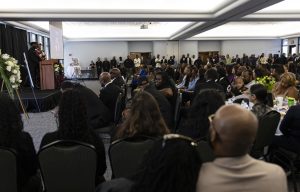S/BAD promotes unity and diversity
October 27, 2004
Diverse races, sizes and dance moves take center stage at thisyear’s Sacramento Black Art of Dance production, entitled”Quilts: Diasporic Tapestries.”
Straying away from a cast made up traditionally of mainly blackartists and dancers, this production is filled with members frommany ethnic backgrounds, as well as celebrating the female form byincluding dancers of all body types &- a wonderful statementto make in the spotlight.
The company is in the process of rebuilding itself, and withmany dancers interested in becoming members, inclusion of diversityseemed a natural decision.
“Quilts: Diasporic Tapstries” is the idea ofAssociate Artistic Director Nathan Jones, after being inspired byhis own quilt-making and the passing of his father.
“The African-American quilting tradition embodies the(S/BAD) mission: to weave together personal her/histories in aneffort to show inherent strength built through a variety oftexture, color, age and ethnic background,” Jones said in theprogram notes.
The show is truly a mixture of color, ethnic backgrounds andcultures, with numbers that reflect not only KatherineDunham’s modern African-Caribbean dance styles, but alsoinfluences from Polynesia in Eric Vianelle’s piece, to bigband and swing in Nzinga Wood’s “Fabric of aWoman’s Soul.”
“Fabric” opens up the show, with a dimly lit stage,six dancers standing alone, and no music. Suddenly, each dancertakes a loud breath and undulates, causing the next dancer to dothe same. This repeats in a creative rhythmic breathing sectionthat closes the number, as well.
The 1920s inspired movements to Jill Scott’s “Talkto Me” are energetic and entertaining, but the awkward lipsynching solo feels more like watching a girl performing in herbedroom mirror than anything ready for the stage.
Conceived and performed by Noah Hayes, “Motherless ChildFinds Comfort” depicts, through poetry and movement, aman’s journey to find his birth mother, ultimately leadinginto a duet with Nicole Manker.
The lighting effects of this piece, crafted by designer KyleLemoi, are vibrant and intriguing, with a circle of star-like poolsof light encompassing Hayes’s body as he searches to discoverwho he is.
Vianelle drew “Churning the Sea of Milk” from histravels around the world to choreograph and utilizes props such asgourds and silk cloths that resemble water. The movements are verymodern, and the dancers appear to be boneless as they twist andturn, emulating dancing in the ocean. The dancers seem to travelunderwater to different exotic locations around the world, takingon the movements of whichever country they inhabit.
With perhaps the most traditional African-Caribbean influences,the duet “Take Me Back” gives the feeling of attendingcultural ceremony. The large, body encompassing manipulations andthrashing of heads and hips were awe inspiring.
The finale was the most interesting and entertaining piece.”Quilting Bee” symbolizes a true quilt and NathanJones’s choreography fuses together African-Caribbean dancingwith modern movements and classic music.
“No Count Blues” by Thas Jones and Sarah Vaughn, wasa closing, high-energy Big Band song. Jones combined traditionaldancing with swing music and proved that different styles andethnicities can be combined to create a smooth and fluentpiece.
Dancer Shauna Segler really stands out in this number, with herlong, fiery hair flying as her body performs perfect, trainedmovements. Even when trying to look at the number as a whole andwatch every dancer equally, it’s difficult to keep your eyesoff of her.
“Quilts: Diasporic Tapestries” plays again thisweekend, with shows Wednesday through Saturday at 8 p.m. and Sundayat 2 p.m. in Solano Hall Dancespace. Tickets are available at theCSUS Ticket Office or at Tickets.com.

























































































































